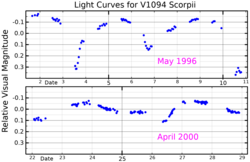V1094 Scorpii
Jump to navigation
Jump to search
 Visual band light curves for V1094 Scorpii, adapted from Wichmann et al. (1998)[1] and Joergens et al. (2001)[2] | |
| Observation data Epoch J2000.0 Equinox J2000.0 | |
|---|---|
| Constellation | Scorpius-Lupus |
| Right ascension | 16h 08m 36.17701s[3] |
| Declination | −39° 23′ 02.4621″[3] |
| Apparent magnitude (V) | 13.48 |
| Characteristics | |
| Spectral type | K6V[4] |
| Variable type | T Tauri-type? |
| Astrometry | |
| Proper motion (μ) | RA: −9.830[3] mas/yr Dec.: +23.435[3] mas/yr |
| Parallax (π) | 6.5086 ± 0.0452 mas[3] |
| Distance | 501 ± 3 ly (154 ± 1 pc) |
| Details[4] | |
| Mass | 0.92 M☉ |
| Radius | 1.9 R☉ |
| Luminosity | 1.7 L☉ |
| Temperature | 4,205 K |
| Age | 2-3 Myr |
| Other designations | |
| Database references | |
| SIMBAD | data |
V1094 Scorpii is a young stellar object in the constellation of Scorpius, located in the young Lupus Star Forming Region.[5] It is being orbited by a protoplanetary disk that extends out to a distance of 300 AU from the host star. There are gaps at 100 AU and 170 AU, with bright rings at 130 AU and 220 AU.[4]
Planetary system
Periodic radial velocity variations in the young star V1094 Scorpii had at first been explained by the presence of a substellar object in a tight orbit.[6] Currently, the presence of a substellar object has been retracted, invoking starspots as the actual cause for observed radial velocity variations.[2]
| Companion (in order from star) |
Mass | Semimajor axis (AU) |
Orbital period (days) |
Eccentricity | Inclination | Radius |
|---|---|---|---|---|---|---|
| b (retracted) | ≤24 MJ | ≈0.065 | 7.2 | ?0 | — | — |
References
- ^ Wichmann, R.; Bouvier, J.; Allain, S.; Krautter, J. (February 1998). "Rotational evolution of pre-main sequence stars in Lupus". Astronomy and Astrophysics. 330: 521–532. Retrieved 19 March 2022.
- ^ a b Joergens, V.; et al. (2001). "The T Tauri star RX J1608.6-3922 - not an eclipsing binary but a spotted single star". Astronomy and Astrophysics. 373 (3): 966–973. arXiv:astro-ph/0105326. Bibcode:2001A&A...373..966J. doi:10.1051/0004-6361:20010684. S2CID 17464041.
- ^ a b c d e Brown, A. G. A.; et al. (Gaia collaboration) (August 2018). "Gaia Data Release 2: Summary of the contents and survey properties". Astronomy & Astrophysics. 616. A1. arXiv:1804.09365. Bibcode:2018A&A...616A...1G. doi:10.1051/0004-6361/201833051. Gaia DR2 record for this source at VizieR.
- ^ a b c van Terwisga, S. E.; et al. (August 2018). "V1094 Scorpii: A rare giant multi-ringed disk around a T Tauri star". Astronomy & Astrophysics. 616: 10. arXiv:1805.03221. Bibcode:2018A&A...616A..88V. doi:10.1051/0004-6361/201832862. A88.
- ^ Hughes, Joanne; et al. (1993). "The distance to the Lupus star formation region". The Astronomical Journal. 105 (2): 571–575. Bibcode:1993AJ....105..571H. doi:10.1086/116454.
- ^ Wichmann, R.; et al. (1997). "T Tauri stars and the Gould Belt near Lupus". Astronomy and Astrophysics. 326: 211–217. Bibcode:1997A&A...326..211W.